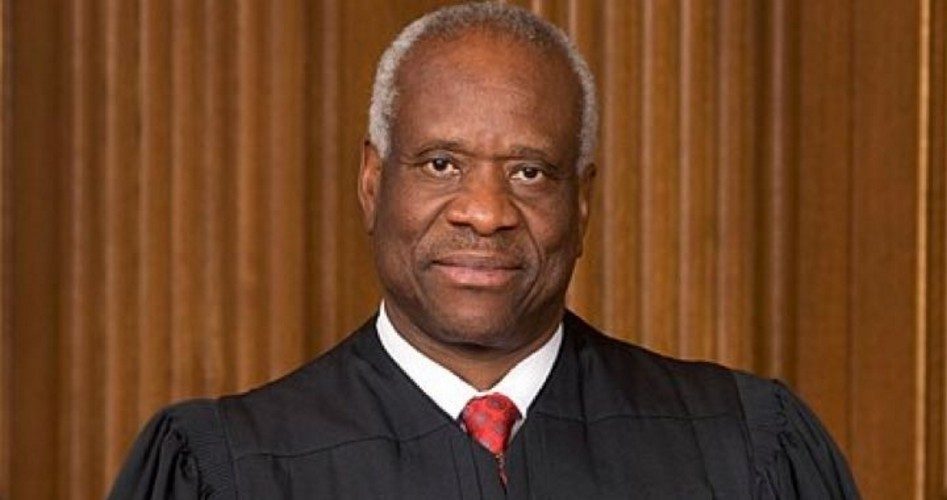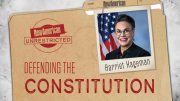
On Tuesday, Supreme Court Justice Clarence Thomas (shown) wrote a scathing dissent to the High Court’s decision to not even take up a case concerning a law passed in California: a law in which gun buyers — even those who already own guns — must undergo a waiting period of 10 days before they can take possession of any firearms that they have already purchased.
Not surprisingly, the Ninth Circuit Court of Appeals, widely regarded as the country’s most liberal federal appellate court, upheld the California law, reversing the federal court decision that had struck it down. Instead of hearing the case on appeal, the U.S. Supreme Court refused to grant the necessary writ of certiorari.
Thomas wrote that this refusal to hear a case involving a constitutionally protected right under the Second Amendment “is symptomatic of the lower courts’ general failure to afford the Second Amendment the respect due an enumerated constitutional right. If a lower court treated other rights so cavalierly, I have little doubt that this Court would intervene. But as evidenced by our continued inaction in this area, the Second Amendment is a disfavored right in this Court.” (Emphasis added.)
Offering as an example of the disrespect the court affords the Second Amendment, Justice Thomas asserted that were a state to place a 10-day waiting period on a woman’s “right” to an abortion, a majority of his colleagues would step in with a review. In another example of the relative disdain in which the Ninth Circuit holds the right to keep and bear arms, its members even struck down a waiting period for nude-dancing lessons. It was the Ninth Circuit that first struck down traditional marriage laws. Yet, when it comes to the Second Amendment, “The right to keep and bear arms is apparently this Court’s constitutional orphan.”
California’s reasoning in passing the waiting period law is that potential buyers might decide against owning a gun. Can one imagine if a state placed a 10-day waiting period before a woman could have an abortion, under the reasoning that the woman might decided not to abort her baby?
California’s waiting period is the second longest of any state. Only eight other states and the federal District of Columbia even have any waiting period.
Two California residents, Brandon Combs and Jeff Silvester, challenged the application of the law. They both were already legal gun owners, arguing that the waiting period is unconstitutional when applied to “subsequent purchasers” (who already own a firearm and are already in the California database, have a valid concealed-carry license, and who clear a background in less than the 10 days of the waiting period). They were aided in their case by the Second Amendment Foundation and the Calguns Foundation.
But the Ninth Circuit argued that the waiting period was reasonable because a person who already owns at least one firearm “may want to purchase a larger capacity weapon that will do more damage when fired into a crowd.” Thomas directly challenged this reasoning, saying that the Supreme Court had ruled in the case District of Columbia v. Heller in 2008, “Because the right to keep and bear arms is enumerated in the Constitution, courts cannot subject laws that burden it to a mere rational-basis review. But the decision [of the Ninth Circuit] did just that. Purporting to apply intermediate scrutiny, the Court of Appeals upheld California’s 10-day waiting period for firearms based solely on its own ‘common sense.’”
Thomas added, “It did so without requiring California to submit relevant evidence, without addressing petitioners’ arguments to the contrary, and without acknowledging the District Court’s factual findings. This deferential analysis was indistinguishable from rational-basis review.”
The District Court had found that individuals who already meet the requirements for a concealed-carry license are uniquely “unlikely” to “engage in impulsive acts of violence,” Thomas noted. The District Court also contradicted the reasoning of the California Legislature that “a waiting period could still work for subsequent purchasers in some circumstances,” Thomas said, calling such reasoning just speculation.
“California did not prove that waiting periods deter subsequent purchasers who want to buy a larger capacity gun. California’s expert identified only one anecdotal example of a subsequent purchaser who had committed an act of gun violence, and the expert conceded that a waiting period would not have deterred that individual,” Thomas continued in his strong dissent to the refusal to grant cert.
Thomas further argued that instead of utilizing such speculative reasoning to infringe upon the Second Amendment right of individuals to keep and bear arms, “[the courts should instead] ask whether the challenged law complies with the text, history, and tradition of the Second Amendment.”
Sadly, whenever the Second Amendment is discussed, this seems to be the last consideration, not only in the courts, but in the popular culture, the media, among political candidates and office holders, and in legislative bodies. Instead, such irrelevant remarks such as whether one needs a certain type of gun to hunt deer or go sport shooting is a common anti-Second Amendment talking point. Even self-protection, as important as that is, was not the primary reason that James Madison placed the Second Amendment in his proposed Bill of Rights.
The primary purpose for the Second Amendment is as a last line of defense against a tyrannical government. As the “father of our country,” George Washington said, “A free people ought not only be armed and disciplined, but they should have sufficient arms and ammunition to maintain a status of independence from any who might attempt to abuse them, which includes their own government.” (Emphasis added.) Of course, any politician making such a remark today would be dismissed as a right-wing “extremist.”
But, as Justice Thomas so aptly said in his blistering dissent, “The Ninth Circuit’s reasoning was the opposite of common sense. Common sense suggests that subsequent purchasers contemplating violence or self-harm would use the gun they already own, instead of taking all the steps to legally buy a new one in California.”
Apparently, such common sense is also lacking in a majority of the present membership of the U.S. Supreme Court.
Photo of Clarence Thomas: Official photo for Supreme Court



